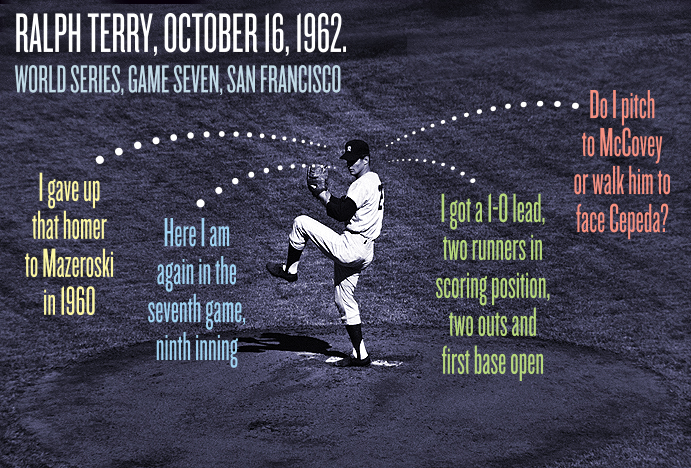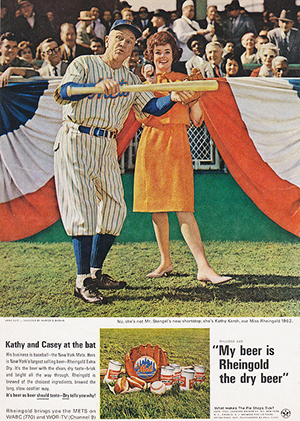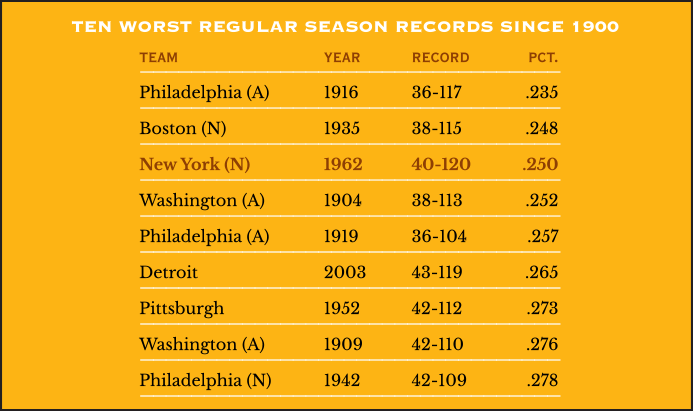THE YEARLY READER
1962: Lined to Second Best
The San Francisco Giants, after an exhilirating pennant race, lose a seven-game World Series when Willie McCovey’s scorching, potential series-winning hit is snared out of the air by New York Yankees second baseman Bobby Richardson.

(Associated Press)
For one paralyzing moment, Ralph Terry thought he was reliving the nightmare. It was Terry who, two years earlier, was on the mound for the New York Yankees when Bill Mazeroski hit the famous walk-off home run to win Game Seven and the 1960 World Series for Pittsburgh. And now here was Terry once again in 1962, with two outs in the bottom of the ninth of Game Seven, watching Willie McCovey’s scorching low line drive scream to his left. If it got through the infield, two runs would score, the San Francisco Giants would win, and Terry would become a two-time World Series goat. All Terry could do was pray that someone with an infielder’s glove could stop McCovey’s shot cold.
Thanks to Bobby Richardson, there would be a someone.
Throughout much of the 1962 season, it was Terry who was the someone most responsible for ensuring the Yankees a third straight trip to the postseason. A once-and-current Yankee who’d done a roundtrip through the active New York-Kansas City pipeline, Terry’s second tour of duty with the Yankees grew better with every year. Following a stingy 16-3 mark in 1961 to let everyone know he hadn’t slipped into an emotional rut one year after Mazeroski’s home run, Terry became the staff workhorse in 1962, grinding out an impressive 23-12 record and 3.15 earned run average in nearly 300 innings of pitching. Along with veteran ace Whitey Ford (17-8, 2.90 ERA), Terry helped anchor a Yankees pitching staff whose 3.70 ERA was just a shade behind Baltimore (3.69) for tops in the American League.
Overall, the Yankees got off to their usual slow start before picking up summertime steam to supplant the early leaders, which on the Fourth of July included, of all teams, the Los Angeles Angels—enjoying only their second year of existence in a 10-team AL.
BTW: The Angels ultimately finished third, 10 games behind the Yankees; it would be their best finish until 1978.
The M&M Boys—Mickey Mantle and Roger Maris—enjoyed productive years to lift the Yanks offensively, but in no way approached the Herculean heights they achieved the year before. Maris’ 33 home runs and 100 runs batted in were good enough to lead the team, but not good enough to please the fans or media, still giving the disputed home run king of 1961 a hard time.
As the Yankees pulled away with their 12th AL pennant in 14 years, the National League race became a monumental duel to the wire between two longstanding rivals now firmly settled in along the Pacific: The San Francisco Giants and Los Angeles Dodgers.
Statistically, both teams were loaded and locked in to ensure each a pennant.
The Giants had some bats: Willie Mays smacked 49 home runs with 141 RBIs, and Orlando Cepeda chimed in with 35 homers and 114 RBIs; the lineup was so crowded with talent, even imposing 24-year-old slugger Willie McCovey couldn’t break into the everyday lineup.
BTW: Mays was finally winning over the hearts and minds of San Franciscans, who viewed him as a New York hero rather than a homegrown one…McCovey hit .293 with 20 home runs in just 224 at-bats.
The Dodgers had some bats: Tommy Davis led the NL with 230 hits, 153 RBIs and a .346 batting average, while king-sized slugger Frank Howard (6’7”, 255 pounds) launched 31 homers with 119 RBIs.
The Giants had some arms: Led by 24-game winner Jack Sanford, the thoroughly solid four-man starting rotation that also included Juan Marichal, Billy O’Dell and Billy Pierce accounted for 77 wins.
The Dodgers had some arms: Don Drysdale won a career-high 25 games in 34 decisions, and Sandy Koufax began the second and far more dominant stage of his career, earning league bests in ERA (2.54) and opposing batting average (.197) even as a finger injury sidelined him for much of the season’s final two months.
There was an additional element to the Dodgers’ arsenal that the Giants lacked: Speed. The Chicago White Sox might had recently reawakened baseball to the concept of the stolen base, but the Dodgers—or more pointedly, Maury Wills—brought basestealing strategy back to levels seldom seen since the deadball era. It didn’t matter that Wills was little more than a singles’ hitter at the plate; once he got on, he quickly turned singles into virtual doubles or triples with an almost scientific ability to steal bases—104 in all, breaking Ty Cobb’s season mark set back in 1915.
If the Giants couldn’t contain Wills by holding him on or pitching out, then they’d do it by excessively watering down the infield. Or so the Dodgers angrily claimed when they came to Candlestick Park for a three-game series in August—one in which they were swept, tightening a typically acrimonious Dodgers-Giants pennant race.
BTW: The Giants’ story: The infield dirt was watered down to keep the blustery Candlestick winds from blowing it around. However, it should be noted that the team voted head groundskeeper Matty Schwab a full World Series share at year’s end.
By mid-September, any muddy tactics didn’t appear to be enough for the Giants. They trailed the Dodgers by four games and lost Mays for a week after he literally collapsed from exhaustion in Cincinnati. But instead of hammering the final nail in the coffin, the Dodgers stubbed their toe. They lost 10 of their final 13 games—including a series sweep by the St. Louis Cardinals at Los Angeles in the season’s final weekend. Allowed to play last-minute catch-up, the Giants took advantage and finished the regular schedule tied with the Dodgers at 101-61.
The ensuing best-of-three tiebreaker, much like the 162 games before it, took on mildly eerie parallels to the historic 1951 Dodgers-Giants tug-of-war. The Giants took the first game, the Dodgers won the second and appeared ready to wrap things up in the third when the Giants pulled a four-run, ninth-inning rally out of the hat to take the pennant at Los Angeles, 6-4.
BTW: Sandy Koufax, ineffective in his return from the injury list, was pounded 8-0 by the Giants…The Giants’ pennant clincher came 11 years to the day that Bobby Thomson’s “Shot Heard ‘Round the World” put away the Dodgers.
While San Francisco and Los Angeles gave a thrilling show at the top of the NL standings, there was entertainment of a more comedic kind provided deep, deep down at the bottom with the expansion performance of the New York Mets.

Casey Stengel, posing with “Miss Rheingold” in a beer ad, was given a hero’s welcome as manager of the first-year New York Mets as National League baseball returned to the Big Apple after a four-year absence. The honeymoon would be short-lived as the Mets won just 40 of 160 games in their maiden campaign.
Ending a four-year vacancy of NL baseball in New York, the Mets began their inaugural season giving up their first-ever run on a balk—starter Roger Craig dropped the ball on the mound—and finished it with Joe Pignatano hitting into a triple play in his last major league at-bat. In between, the Mets lost an all-time record 120 games for 72-year-old manager Casey Stengel, who reportedly spent much of his heralded return to baseball dozing away in the dugout.
How awful were the Mets? They lost their first nine games and later suffered losing streaks of 11, 13 and 17 games. Their pitching rotation included two 20-game losers (Roger Craig and Al Jackson), and a third (Jay Hook) with 19. They lost 30 of 36 games against the league’s two ex-New York clubs, the Giants and Dodgers, and 13 of 16 against the other NL expansion team, the Houston Colt .45s. On back-to-back days they allowed opposing hitters (Hank Aaron and Lou Brock) to smash home runs over the macro-distant center field fence at the Polo Grounds; the Giants had allowed only one such blast in nearly 50 years as the ballpark’s tenants. The Mets were the victims of the majors’ only no-hitter in 1962, pitched by Sandy Koufax.
The celebrated poster child for the 1962 Mets was starting first baseman Marv Throneberry, and for good reason. Throneberry had power but mostly produced outs (usually on strikes), played erratic defense, and committed enough sensational gaffes to repeatedly qualify for the funny pages. Throneberry’s most hilarious moment occurred when, after hitting a triple, he was called out for not touching second base. Stengel awoke to argue, only to be told that Throneberry had missed first base as well.
Throneberry became ultimate fodder for an emerging generation of New York baseball fans tiring of the snobby clientele at Yankee Stadium. Like a matinee movie audience, the younger, more rowdy fans embraced the Mets and their over-the-hill gang of heroes—which included former New York baseball stars Gil Hodges, Don Zimmer, Gene Woodling and Roger Craig—as the new clown princes of baseball. Though not a major hit at the box office—they drew just under a million fans—the Mets established a solid base of devotees that would serve them well in the years to come, especially when the team’s play on the field would suddenly turn from pitiful to amazing.
BTW: A seven-year veteran, Throneberry would bat only 14 more times in 1963 before being released by the Mets, never to return to the majors.
Not for Your Portfolio
Although the Mets established an all-time record with 120 losses, their .250 winning percentage doesn’t rank them at the very top of the the 10 truly worst teams in modern major league history.

The World Series, which the Mets seemed eons away from reaching for the time being, became a ping-pong affair through the first six games as the Yankees and Giants followed each other’s victory with one of their own.
For all the regular season success Ralph Terry had contributed to the Yankees over the past three years, he still had to overcome his label as a postseason bust, having gone 0-3 in four previous World Series starts. In didn’t help that his team couldn’t hit as he lost Game Two at San Francisco, 2-0. Terry pitched well again in Game Five at New York, but sweated through eight close innings until Tom Tresh swatted a three-run homer to give the Yankees the late lead—and, finally, Terry’s first Fall Classic victory, 5-3.
An unusually powerful early-season storm on the West Coast kept the final two games at San Francisco on hold for three days, allowing the two New York aces—Terry and Whitey Ford—to rest up and be available for a third Series start. Ford, who earlier in Game One had his Series-record string of consecutive scoreless innings snapped at 33.2—and was otherwise fairly mortal—was beaten by the Giants’ Billy Pierce in Game Six, 5-2, setting up Game Seven with Terry as the starter.
BTW: The victory gave the veteran Pierce, in his first year with the Giants, a 13-0 record at Candlestick for 1962.
Dissecting the Zeroes
A breakdown of Whitey Ford’s World Series record for throwing consecutive scoreless innings—and that of the mark he broke in 1961, held for 43 years by one Babe Ruth.

The Yankees, doing all they could to support Terry against a tough Jack Sanford, could only scratch a solo run across in the fourth when Bill Skowron scored on a double play ball. But Terry was holding the razor-thin lead, blanking the Giants through eight innings on just two hits. As the Giants readied to send the heart of the order up in the ninth, Terry was either three outs away from redemption—or a Giant rally away from being branded a World Series goat two times over.
After Matty Alou led off with a bunt hit, Terry stayed composed by striking out the next two batters. That left the season up to Willie Mays, who doubled down the right-field line. Astonishingly, Alou could not score from first with two outs; soggy from the rains, the outfield grass kept the ball from speeding into the corner—and a combination of perfect throws from Roger Maris in the outfield and Bobby Richardson as the cut-off man to home plate made it suicidal for Alou to try and tie the game.
A burden the size of Bill Mazeroski was suddenly placed upon Terry’s shoulders. With two outs and first base open, Yankees manager Ralph Houk visited Terry on the mound and discussed the right-hander’s options: Either go after the next batter, left-handed slugging Willie McCovey—who slammed a towering homer off Terry in Game Two and, in his last at-bat, had tripled to center—or walk him to load the bases and set up a force at any base, leaving it up to right-handed hitting Orlando Cepeda. As if Terry didn’t have enough pressure, Houk punted and asked his pitcher to make the choice.
Terry decided to defy logic and pitch to McCovey.
On the first pitch, it looked like Pittsburgh, The Sequel as McCovey lashed a deep drive down the right-field line—but it hooked foul. McCovey’s next swing went fair; he lacerated a low, hard drive through the right side of the infield, looking destined to get through and win the Series for the Giants. Instead, it found a path aimed straight at Richardson, who only had to lean to his left from where he was positioned to make the catch. Terry had found redemption, if not without a coronary.
BTW: McCovey would say in later years that it was one of the hardest balls he ever hit.
The Yankees’ hard-fought triumph, accomplished despite a .199 team batting average, would be their 20th in 40 years.
And it would be their last until the Age of Steinbrenner.
 Forward to 1963: The Sandman Cometh After years of wildness and frustration, the Los Angeles Dodgers’ Sandy Koufax becomes an ace for the ages.
Forward to 1963: The Sandman Cometh After years of wildness and frustration, the Los Angeles Dodgers’ Sandy Koufax becomes an ace for the ages.
 Back to 1961: The Greatest Feat Ever Performed* Roger Maris experiences a year of triumph and troment as he threatens Babe Ruth’s season home run record.
Back to 1961: The Greatest Feat Ever Performed* Roger Maris experiences a year of triumph and troment as he threatens Babe Ruth’s season home run record.
 1962 Leaders & Honors Our list of baseball’s top 10 hitters and pitchers in both the American League and National League for the 1962 baseball season, as well as the awards and honors given to the game’s top achievers of the year.
1962 Leaders & Honors Our list of baseball’s top 10 hitters and pitchers in both the American League and National League for the 1962 baseball season, as well as the awards and honors given to the game’s top achievers of the year.
 The 1960s: Welcome to My Strike Zone In a decade where baseball as a tradition is turning stale with America’s emerging counter-culturism, major league owners see its biggest problem to be, of all things, an overabundance of offense in the game. The result? An increased strike zone, further contributing to a downward spiral in attendance, but greatly aiding an already talented batch of pitchers.
The 1960s: Welcome to My Strike Zone In a decade where baseball as a tradition is turning stale with America’s emerging counter-culturism, major league owners see its biggest problem to be, of all things, an overabundance of offense in the game. The result? An increased strike zone, further contributing to a downward spiral in attendance, but greatly aiding an already talented batch of pitchers.


 Maury Wills discusses the critical moments of his life in baseball that made him one of the game’s great basestealers.
Maury Wills discusses the critical moments of his life in baseball that made him one of the game’s great basestealers. Ed Roebuck opens up on his times with both the Brooklyn and Los Angeles Dodgers, and his status as baseball’s fungo king.
Ed Roebuck opens up on his times with both the Brooklyn and Los Angeles Dodgers, and his status as baseball’s fungo king.


